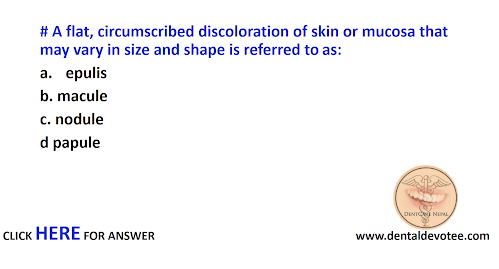# A flat, circumscribed discoloration of skin or mucosa that may vary in size and shape is referred to as:
a. epulis
b. macule
c. nodule
d papule
The correct answer is B. Macule.
Macules: These are lesions that are flush with the adjacent mucosa and that are noticeable because of their difference in color from normal skin or mucosa. They may be red due to increased vascularity or inflammation, or pigmented due to the presence of melanin, hemosiderin, and foreign material (including the breakdown products of medications). A good example in the oral cavity is the melanotic macule.
Papules: These are lesions raised above the mucosal surface that are smaller than 1.0 cm in diameter (some use 0.5 cm for oral mucosal lesions). They may be slightly domed, or flat‐topped. Papules are seen in a wide variety of diseases, such as the yellow‐white papules of pseudomembranous candidiasis.
Plaques: These are raised lesions that are greater than 1 cm in diameter; they are essentially large papules.
Nodules: These lesions are present within the deep mucosa. The lesions may also protrude above the mucosa forming a characteristic dome‐shaped structure. A good example of an oral mucosal nodule is the irritation fibroma.
Vesicles: These are small blisters containing clear fluid that are less than 1 cm in diameter.
Bullae: These are elevated blisters containing clear fluid that are greater than 1 cm in diameter.
Erosions: These are red lesions often caused by the rupture of vesicles or bullae, or trauma and are generally moist on the skin. However, they may also result from thinning or atrophy of the epithelium in inflammatory diseases such as lichen planus. These should not be mistaken for ulcers, which are covered with fibrin and are yellow.
Pustules: These are blisters containing purulent material and appear yellow.
Ulcers: These are well‐circumscribed, sometimes depressed lesions with an epithelial defect that is covered by a fibrin membrane, resulting in a yellow‐white appearance. A good example is an aphthous ulcer.
Purpura: These are reddish to purple discolorations caused by blood from vessels leaking into the connective tissue. These lesions do not blanch when pressure is applied and are classified by size as petechiae (less than 0.3 cm), purpura (0.4–0.9 cm), or ecchymoses (greater than 1 cm).

No comments:
Post a Comment
Add Your Comments or Feedback Here